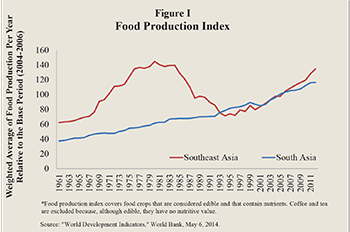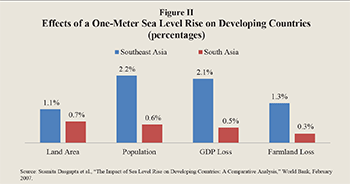Recent regional studies claim the Earth is beginning to feel the effects of climate change, especially South and Southeast Asia. Yet, thus far, climate change has had no discernible effect on these regions, and recent analyses indicate adaptation is the preferable strategy to deal with any effects that may occur in the future.
South and Southeast Asia. Studies have focused on South and Southeast Asia due to their unique vulnerability to projected effects of climate change: a decline in agricultural production, rising sea levels, increased flooding, biodiversity loss, drought and more intense natural disasters. Countries in these regions are considered especially vulnerable because most are situated on peninsulas or islands and have highly populated coastal cities. With much of their investment and development concentrated in coastal areas, these regions have the most to lose if predictions pan out.
Maplecroft, a global risk analysis company, ranks Bangladesh as the country most at risk to climate change effects, with Cambodia, the Philippines, India, Pakistan, Vietnam, Indonesia and Thailand not far behind. Africa and the Caribbean harbor many other at-risk countries, but the five cities at the most “extreme risk” – Dhaka, Mumbai, Kolkata, Manila and Bangkok – all lie in South or Southeast Asia. Indeed, reports from the Intergovernmental Panel on Climate Change (IPCC) conclude climate change will slow economic growth, erode food security and trigger new poverty traps, particularly in these two regions.
Food Security. The World Health Organization (WHO) measures food security by supply, accessibility and consumption. Many observers fear rising temperatures will increase food insecurity in South and Southeast Asia. However, food production has increased dramatically over the past 50 years (see Figure I). Though Southeast Asian food production dipped in the 1970s, it recovered and has substantially increased since the 1990s.

Furthermore, the amount of arable land has remained stable in South Asia and has increased in Southeast Asia, signaling climate change has yet to have an effect on food security and that food production will be able to keep up. Indeed, agronomist and geographer Craig Idso estimates that, worldwide, increased plant production due to increased levels of CO2 in the Earth’s atmosphere grew in annual value from $18.5 billion in 1961 to over $140 billion by 2011 and amounted to $3.2 trillion over a 50-year period. Thus, food production in South and Southeast Asia will likely continue its upward trend beyond 2011.
Biodiversity. Another fear regarding climate change is widespread biodiversity loss. According to a study published by TRENDS in Ecology and Evolution, Southeast Asia is one of the world’s richest areas in number of species and in endemism — a species’ uniqueness to a geographic location.Though the study’s authors fear losses in biodiversity, none of the threats they cite – forest conversion, forest fires, hunting for bushmeat and the wildlife trade – involve climate change.
Coral Reef Bleaching. Climate change has already affected biodiversity in South and Southeast Asia, with bleached coral reefs correlating with rising sea temperatures. However, sea temperature rises appear to have tapered off in recent years, allowing the coral to adapt over time. Indeed, a study published by the Public Library of Science found that rising sea temperatures have been destroying coral reefs in Southeast Asia, but the reefs have adapted to the growing thermal stress over the past 20 years.
Rising Sea Levels. Scientists agree sea levels will continue to rise gradually, but there is no consensus on the exact range. IPCC lead scientists John Church and Neil White predict only a 28-to-34-centimeter rise – roughly one-third of one meter – by 2100. According to a World Bank report, even a one-meter sea level rise would affect only 1 percent to 2 percent of the land area, population and farmland in developing countries (see Figure II). A one meter rise would reduce GDP in the affected countries by 0.5 percent to 2 percent.

Growth and Adaptation to Climate Change. Some believe that regional economic growth has been hindered by infrastructure destruction due to more severe natural disasters. However, there is evidence that climate change has had beneficial effects on these economies so far and will continue to help over the long term. With GDP growth averaging near five and a half percent, South and Southeast Asia are among the fastest growing regions globally and appear strong enough to implement adaptation projects.
Thirteen of the 18 nations in these regions have already implemented 182 climate change-related measures to mitigate or adapt to the effects of climate change. However, the majority of these projects are designed to mitigate, rather than adapt to, climate change. Mitigation generally means projects, regulations or taxes aimed at reducing emissions of greenhouse gases implicated in climate change. Adaptation strategies, by contrast, include focusing on natural disaster recovery and restoration, coral rehabilitation, water resource management, protecting wildlife and so forth.
Given the uncertainty in climate science, adaptation appears to be a more cost-effective approach than mitigation.
Tanner Davis is a research associate with the National Center for Policy Analysis.